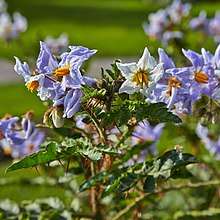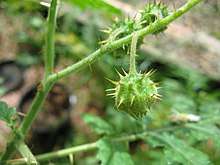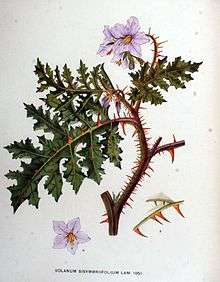Solanum sisymbriifolium
Solanum sisymbriifolium is commonly known as vila-vila,[1] sticky nightshade,[2] red buffalo-bur,[3] the fire-and-ice plant, litchi tomato, or Morelle de Balbis.[4]
| Solanum sisymbriifolium | |
|---|---|
 | |
| Scientific classification | |
| Kingdom: | Plantae |
| Clade: | Tracheophytes |
| Clade: | Angiosperms |
| Clade: | Eudicots |
| Clade: | Asterids |
| Order: | Solanales |
| Family: | Solanaceae |
| Genus: | Solanum |
| Species: | S. sisymbriifolium |
| Binomial name | |
| Solanum sisymbriifolium | |
| Synonyms | |
|
Many, see text | |
The small edible fruits are red on the outside and yellow inside. It grows inside a spiny, green husk. The fruit is ripe when it is easily removed from the stem. The flavor resembles sour cherries and a little bit like a tomato.[4]
This plant has been used as a trap crop to protect potatoes from potato cyst nematode.[5] The stems and leaves contain solasodine which makes the plant very resistant to many pests and diseases, with the exception of potato beetles and tomato hornworms. It can also be used as a hedge plant to keep animals out of a garden, because it is covered with prickles (erroneously called thorns).[4]
Synonyms


The sticky nightshade has been described under a number of illegitimate scientific names, many of them quite ambiguous homonyms:[6]
- Solanum balbisii Dunal
- Solanum bipinnatifidum Larrañaga
- Solanum brancaefolium Jacq.
- Solanum decurrens Balb.
- Solanum edule Vell.
- Solanum formosum Weinm.
- Solanum inflatum Hornem.
- Solanum mauritianum Willd. ex Roth (preoccupied)
- Solanum opuliflorum Port. ex Walp. (nomen nudum)
- Solanum opuliflorum Port. ex Dunal (nomen nudum)
- Solanum rogersii S.Moore
- Solanum sabeanum Buckley
- Solanum subviscidum Schrank
- Solanum thouinii C.C.Gmel.
- Solanum viscidum Schweigg.
- Solanum viscosum Lag.
- Solanum xanthacanthum Willd. ex Walp. (nomen nudum)
Several forms and varieties have been named,[6] but these are generally not considered distinct today:
- Solanum sisymbriifolium var. purpureiflorum Dunal
- Solanum sisymbriifolium forma albiflorum Kuntze
- Solanum sisymbriifolium var. bipinnatipartitum Dunal
- Solanum sisymbriifolium var. brevilobum Dunal
- Solanum sisymbriifolium var. gracile Mattos
- Solanum sisymbriifolium var. heracleifolium Sendtn.
- Solanum sisymbriifolium forma lilacinum Kuntze
- Solanum sisymbriifolium var. macrocarpum Kuntze
- Solanum sisymbriifolium var. oligospermum (Sendtn.) Dunal
References
- Friends of Vila-vila url=https://www.facebook.com/groups/673016442744077/
- "Solanum sisymbriifolium". Natural Resources Conservation Service PLANTS Database. USDA. Retrieved 17 November 2015.
- "BSBI List 2007". Botanical Society of Britain and Ireland. Archived from the original (xls) on 2015-01-25. Retrieved 2014-10-17.
- Litchi Tomato article in Mother Earth News, December 2009
- Introducing Solanum sisymbriifolium as a trap crop for potato cyst nematodes in the UK. Version of 2015-JUL-03. Retrieved 2007-AUG-02
- Solanum sisymbriifolium. Retrieved 2008-SEP-25
External links
| Wikimedia Commons has media related to Solanum sisymbriifolium. |